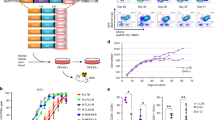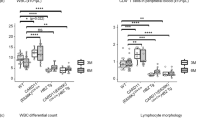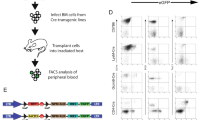Abstract
Using murine Moloney leukemia virus (MMLV)-based proviral insertional mutagenesis, we previously showed a preferential targeting of a small region in the Hoxa gene locus in E2A–PBX1-induced lymphoid leukemia resulting in the overexpression of several Hoxa genes including Hoxa10, Hoxa9 and Hoxa7. This observation suggested a functional interaction between Hox gene overexpression and E2A–PBX1 in lymphoid tumors. To further explore this possibility, we generated a series of compound E2A–PBX1 × Hox transgenic mice and tested the genetic interaction between these genes in the generation of lymphoid leukemia in vivo. Results presented in this report show that the onset of T-cell leukemia is significantly accelerated in E2A–PBX1 × Hoxb4 compound transgenic animals when compared with control E2A–PBX1 or Hoxb4 littermates. Hoxa9 appears less potent than Hoxb4 to accelerate E2A–PBX1-induced T-cell leukemia in mice. E2A–PBX1-induced T-cell leukemias express much higher levels of Hoxa genes than MMLV-induced counterparts, possibly suggesting a contribution of these genes to T-cell transformation by E2A–PBX1. Collectively, these data provide the first genetic evidence showing oncogenic collaboration between E2A–PBX1 and a Hox gene in lymphoid malignancies in vivo and document the specific deregulation of a subgroup of Hoxa genes in these leukemias.
This is a preview of subscription content, access via your institution
Access options
Subscribe to this journal
Receive 50 print issues and online access
$259.00 per year
only $5.18 per issue
Buy this article
- Purchase on Springer Link
- Instant access to full article PDF
Prices may be subject to local taxes which are calculated during checkout




Similar content being viewed by others
References
Armstrong SA, Look AT . (2005). Molecular genetics of acute lymphoblastic leukemia. J Clin Oncol 23: 6306–6315.
Azpiazu N, Morata G . (1998). Functional and regulatory interactions between Hox and extradenticle genes. Genes Dev 12: 261–273.
Bain G, Engel I, Robanus Maandag EC, Te Riele HP, Voland JR, Sharp LL et al. (1997). E2A deficiency leads to abnormalities in alphabeta T-cell development and to rapid development of T-cell lymphomas. Mol Cell Biol 17: 4782–4791.
Bain G, Maandag EC, Izon DJ, Amsen D, Kruisbeek AM, Weintraub BC et al. (1994). E2A proteins are required for proper B cell development and initiation of immunoglobulin gene rearrangements. Cell 79: 885–892.
Bergeron J, Clappier E, Cauwelier B, Dastugue N, Millien C, Delabesse E et al. (2006). HOXA cluster deregulation in T-ALL associated with both a TCRD-HOXA and a CALM-AF10 chromosomal translocation. Leukemia 20: 1184–1187.
Bijl J, Sauvageau M, Thompson A, Sauvageau G . (2005). High incidence of proviral integrations in the Hoxa locus in a new model of E2a-PBX1-induced B-cell leukemia. Genes Dev 19: 224–233.
Caudell D, Zhang Z, Chung YJ, Aplan PD . (2007). Expression of a CALM-AF10 fusion gene leads to Hoxa cluster overexpression and acute leukemia in transgenic mice. Cancer Res 67: 8022–8031.
Cauwelier B, Cave H, Gervais C, Lessard M, Barin C, Perot C et al. (2007). Clinical, cytogenetic and molecular characteristics of 14 T-ALL patients carrying the TCRbeta-HOXA rearrangement: a study of the Groupe Francophone de Cytogenetique Hematologique. Leukemia 21: 121–128.
Cellot S, Krosl J, Chagraoui J, Meloche S, Humphries RK, Sauvageau G . (2007). Sustained in vitro trigger of self-renewal divisions in Hoxb4hiPbx1(10) hematopoietic stem cells. Exp Hematol 35: 802–816.
Chang CP, De Vivo I, Cleary ML . (1997). The Hox cooperativity motif of the chimeric oncoprotein E2a-Pbx1 is necessary and sufficient for oncogenesis. Mol Cell Biol 17: 81–88.
Dedera DA, Waller EK, LeBrun DP, Sen-Majumdar A, Stevens ME, Barsh GS et al. (1993). Chimeric homeobox gene E2A–PBX1 induces proliferation, apoptosis, and malignant lymphomas in transgenic mice. Cell 74: 833–843.
Dik WA, Brahim W, Braun C, Asnafi V, Dastugue N, Bernard OA et al. (2005). CALM-AF10+ T-ALL expression profiles are characterized by overexpression of HOXA and BMI1 oncogenes. Leukemia 19: 1948–1957.
Ferrando AA, Armstrong SA, Neuberg DS, Sallan SE, Silverman LB, Korsmeyer SJ et al. (2003). Gene expression signatures in MLL-rearranged T-lineage and B-precursor acute leukemias: dominance of HOX dysregulation. Blood 102: 262–268.
Hogan B . (1983). Molecular biology. Enhancers, chromosome position effects, and transgenic mice. Nature 306: 313–314.
Hough MR, Takei F, Humphries RK, Kay R . (1994). Defective development of thymocytes overexpressing the costimulatory molecule, heat-stable antigen. J Exp Med 179: 177–184.
Kamps MP, Baltimore D . (1993). E2A–Pbx1, the t(1;19) translocation protein of human pre-B-cell acute lymphocytic leukemia, causes acute myeloid leukemia in mice. Mol Cell Biol 13: 351–357.
Kamps MP, Murre C, Sun XH, Baltimore D . (1990). A new homeobox gene contributes the DNA binding domain of the t(1;19) translocation protein in pre-B ALL. Cell 60: 547–555.
Kroon E, Krosl J, Thorsteinsdottir U, Baban S, Buchberg AM, Sauvageau G . (1998). Hoxa9 transforms primary bone marrow cells through specific collaboration with Meis1a but not Pbx1b. EMBO J 17: 3714–3725.
Kroon E, Thorsteinsdottir U, Mayotte N, Nakamura T, Sauvageau G . (2001). NUP98-HOXA9 expression in hemopoietic stem cells induces chronic and acute myeloid leukemias in mice. EMBO J 20: 350–361.
Krosl J, Sauvageau G . (2000). AP-1 complex is effector of Hox-induced cellular proliferation and transformation. Oncogene 19: 5134–5141.
Krosl J, Austin P, Beslu N, Kroon E, Humphries RK, Sauvageau G . (2003). In vitro expansion of hematopoietic stem cells by recombinant TAT-HOXB4 protein. Nat Med 9: 1428–1432.
LeBrun DP, Cleary ML . (1994). Fusion with E2A alters the transcriptional properties of the homeodomain protein PBX1 in t(1;19) leukemias. Oncogene 9: 1641–1647.
Look AT . (1997). Oncogenic transcription factors in the human acute leukemias. Science 278: 1059–1064.
Lu Q, Wright DD, Kamps MP . (1994). Fusion with E2A converts the Pbx1 homeodomain protein into a constitutive transcriptional activator in human leukemias carrying the t(1;19) translocation. Mol Cell Biol 14: 3938–3948.
Mann RS . (1995). The specificity of homeotic gene function. Bioessays 17: 855–863.
Medina-Martinez O, Ramirez-Solis R . (2003). In vivo mutagenesis of the Hoxb8 hexapeptide domain leads to dominant homeotic transformations that mimic the loss-of-function mutations in genes of the Hoxb cluster. Dev Biol 264: 77–90.
Nourse J, Mellentin JD, Galili N, Wilkinson J, Stanbridge E, Smith SD et al. (1990). Chromosomal translocation t(1;19) results in synthesis of a homeobox fusion mRNA that codes for a potential chimeric transcription factor. Cell 60: 535–545.
Pineault N, Abramovich C, Ohta H, Humphries RK . (2004). Differential and common leukemogenic potentials of multiple NUP98-Hox fusion proteins alone or with Meis1. Mol Cell Biol 24: 1907–1917.
Sanyal M, Tung JW, Karsunky H, Zeng H, Selleri L, Weissman IL et al. (2007). B-cell development fails in the absence of the Pbx1 proto-oncogene. Blood 109: 4191–4199.
Sauvageau G, Thorsteinsdottir U, Hough MR, Hugo P, Lawrence HJ, Largman C et al. (1997). Overexpression of HOXB3 in hematopoietic cells causes defective lymphoid development and progressive myeloproliferation. Immunity 6: 13–22.
Sauvageau G, Thorsteinsdottir U, Mayotte N, Jerome LJ . (2001). Evidence that chromosome instability and stem cell expansion cooperate to induce leukemia in mice. Blood 98 (Part: I): 836a.
Soulier J, Clappier E, Cayuela JM, Regnault A, Garcia-Peydro M, Dombret H et al. (2005). HOXA genes are included in genetic and biologic networks defining human acute T-cell leukemia (T-ALL). Blood 106: 274–286.
Speleman F, Cauwelier B, Dastugue N, Cools J, Verhasselt B, Poppe B et al. (2005). A new recurrent inversion, inv(7)(p15q34), leads to transcriptional activation of HOXA10 and HOXA11 in a subset of T-cell acute lymphoblastic leukemias. Leukemia 19: 358–366.
Su X, Drabkin H, Clappier E, Morgado E, Busson M, Romana S et al. (2006). Transforming potential of the T-cell acute lymphoblastic leukemia-associated homeobox genes HOXA13, TLX1, and TLX3. Genes Chromosomes Cancer 45: 846–855.
Taghon T, Stolz F, De Smedt M, Cnockaert M, Verhasselt B, Plum J et al. (2002). HOX-A10 regulates hematopoietic lineage commitment: evidence for a monocyte-specific transcription factor. Blood 99: 1197–1204.
Taghon T, Thys K, De Smedt M, Weerkamp F, Staal FJ, Plum J et al. (2003). Homeobox gene expression profile in human hematopoietic multipotent stem cells and T-cell progenitors: implications for human T-cell development. Leukemia 17: 1157–1163.
Thompson A, Quinn MF, Grimwade D, O'Neill CM, Ahmed MR, Grimes S et al. (2003). Global down-regulation of HOX gene expression in PML-RARalpha+acute promyelocytic leukemia identified by small-array real-time PCR. Blood 101: 1558–1565.
Thorsteinsdottir U, Krosl J, Kroon E, Haman A, Hoang T, Sauvageau G . (1999). The oncoprotein E2A–Pbx1a collaborates with Hoxa9 to acutely transform primary bone marrow cells. Mol Cell Biol 19: 6355–6366.
Thorsteinsdottir U, Mamo A, Kroon E, Jerome L, Bijl J, Lawrence HJ et al. (2002). Overexpression of the myeloid leukemia-associated Hoxa9 gene in bone marrow cells induces stem cell expansion. Blood 99: 121–129.
Thorsteinsdottir U, Sauvageau G, Hough MR, Dragowska W, Lansdorp PM, Lawrence HJ et al. (1997). Overexpression of HOXA10 in murine hematopoietic cells perturbs both myeloid and lymphoid differentiation and leads to acute myeloid leukemia. Mol Cell Biol 17: 495–505.
Troussard X, Rimokh R, Valensi F, Leboeuf D, Fenneteau O, Guitard AM et al. (1995). Heterogeneity of t(1;19)(q23;p13) acute leukaemias. French Haematological Cytology Group. Br J Haematol 89: 516–526.
van Dijk MA, Peltenburg LT, Murre C . (1995). Hox gene products modulate the DNA binding activity of Pbx1 and Pbx2. Mech Dev 52: 99–108.
van Dijk MA, Voorhoeve PM, Murre C . (1993). Pbx1 is converted into a transcriptional activator upon acquiring the N-terminal region of E2A in pre-B-cell acute lymphoblastoid leukemia. Proc Natl Acad Sci USA 90: 6061–6065.
Van Vlierberghe P, van Grotel M, Tchinda J, Lee C, Beverloo HB, van der Spek PJ et al. (2008). The recurrent SET-NUP214 fusion as a new HOXA activation mechanism in pediatric T-cell acute lymphoblastic leukemia. Blood 111: 4668–4680.
Zhang XB, Beard BC, Trobridge GD, Wood BL, Sale GE, Sud R et al. (2008). High incidence of leukemia in large animals after stem cell gene therapy with a HOXB4-expressing retroviral vector. J Clin Invest 118: 1502–1510.
Acknowledgements
We thank Melanie Frechette for assistance with the animal care and transplantation experiments, and to the personnel from the transgenic animal facility at the Institute for Clinical Research of Montreal (IRCM) for the generation of Hoxb4 and Hoxa9 transgenic lines. We also thank Eric Massicotte and Martine Dupuis from the flow cytometry service of IRCM, and Danielle Gagné from the flow cytometry service of IRIC for assistance in FACS analysis. Dr Alex Thompson (Queen's University, Belfast, UK) is thanked for critically reading the manuscript. This work was supported by funds from the Canadian Cancer Society through a NCIC grant to GS (no. 018478) and the Canada Research Chair program also to GS.
Author information
Authors and Affiliations
Corresponding author
Additional information
Supplementary Information accompanies the paper on the Oncogene website (http://www.nature.com/onc)
Rights and permissions
About this article
Cite this article
Bijl, J., Krosl, J., Lebert-Ghali, CE. et al. Evidence for Hox and E2A–PBX1 collaboration in mouse T-cell leukemia. Oncogene 27, 6356–6364 (2008). https://doi.org/10.1038/onc.2008.233
Received:
Revised:
Accepted:
Published:
Issue Date:
DOI: https://doi.org/10.1038/onc.2008.233
Keywords
This article is cited by
-
High WBP5 expression correlates with elevation of HOX genes levels and is associated with inferior survival in patients with acute myeloid leukaemia
Scientific Reports (2020)
-
Oligomeric self-association contributes to E2A-PBX1-mediated oncogenesis
Scientific Reports (2019)
-
Repression of Hox genes by LMP1 in nasopharyngeal carcinoma and modulation of glycolytic pathway genes by HoxC8
Oncogene (2015)
-
Dual function of polycomb group proteins in differentiated murine T helper (CD4+) cells
Journal of Molecular Signaling (2011)



